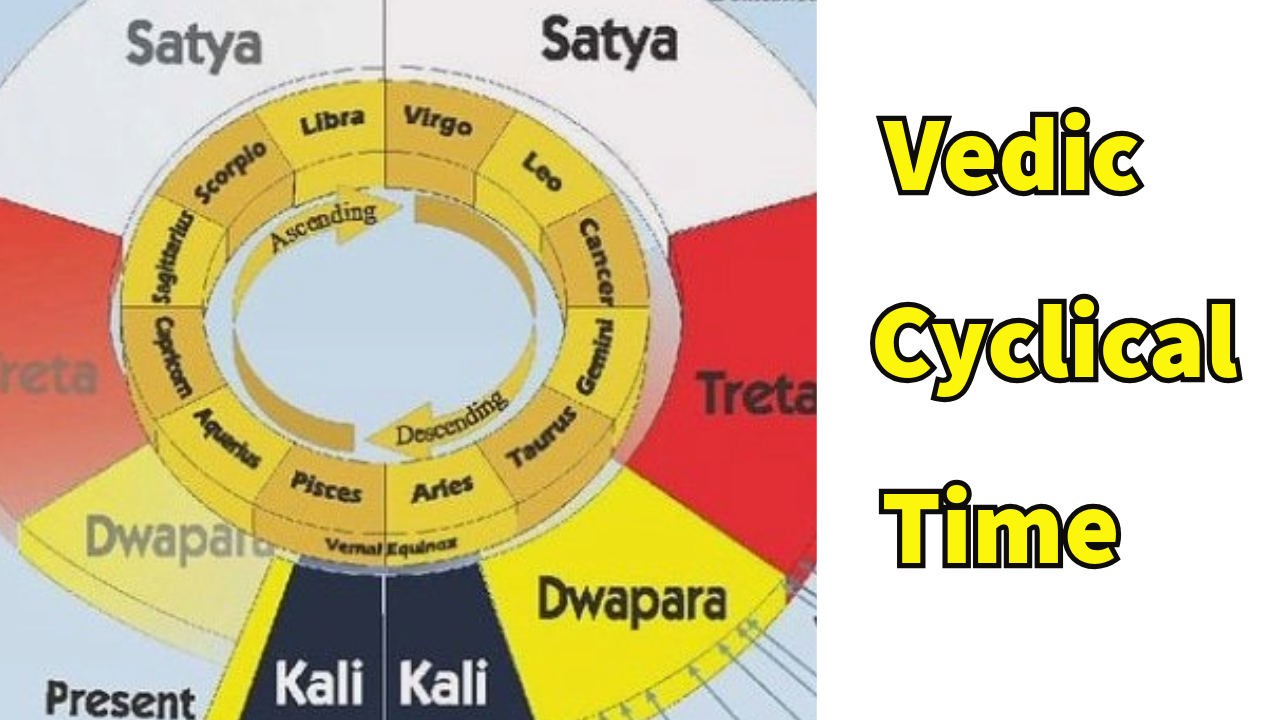
Hindu Vedic texts describe four Yugas (world ages) in a Yuga Cycle—Krita (Satya) Yuga, Treta Yuga, Dwapara Yuga, and Kali Yuga—where, starting in order from the first age, each Yuga’s length decreases by one-fourth (25%), giving proportions of 4:3:2:1
As a Yuga Cycle progresses through the four Yugas, each Yuga’s length and humanity’s general moral and physical state within each Yuga decrease by one-fourth.
Each Yuga is characterized by varying degrees of virtue and vice, wisdom and ignorance, and dharma (righteousness) and adharma (unrighteousness).
1. Satya Yuga (The Age of Truth)
Satya Yuga, also known as the Golden Age or the Age of Truth, is the first and most revered of the Yugas. It is characterized by a time of truth, virtue, and divine presence. In this era, humanity is said to live in harmony with the divine, and righteousness prevails. The divine essence is fully manifest, and people are endowed with immense wisdom and spiritual purity. The moral and ethical standards are at their highest, and there is no need for religious practices or rituals since truth and righteousness are innate.
In this age, the human lifespan is said to be the longest, and there is no suffering or conflict. The concept of Dharma is fully realized, and the divine is perceived directly by all. The natural world is in its prime, reflecting the purity and perfection of this age.
2. Treta Yuga (The Age of Treta)
Following Satya Yuga is Treta Yuga, often referred to as the Silver Age. This period marks a gradual decline in virtue and an increase in the need for religious practices and rituals to maintain Dharma. Although righteousness still prevails, it is somewhat diminished compared to the previous age. In Treta Yuga, humanity begins to experience the emergence of moral and spiritual decay.
In this era, the lifespan of human beings decreases, and the divine presence becomes less direct. The need for sacrifices, rituals, and religious observances arises to uphold Dharma and compensate for the growing imperfections. The epic Ramayana is set in Treta Yuga, reflecting the narrative of divine intervention and the heroic struggle to restore righteousness.
3. Dwapara Yuga (The Age of Dwapara)
Dwapara Yuga, or the Bronze Age, represents a further decline in the moral and spiritual quality of humanity. During this age, virtue and righteousness are significantly diminished, and the human experience becomes more fraught with conflict and suffering. Dharma and adharma are in constant flux, and the balance between them becomes more precarious.
In Dwapara Yuga, the lifespan of human beings continues to decrease, and religious practices become more complex and ritualistic. The Mahabharata, another epic of the Vedic tradition, is set in this age, depicting the moral and ethical challenges faced by individuals and societies. The epic highlights the role of divine intervention and the consequences of human actions in the struggle to restore righteousness.
4. Kali Yuga (The Age of Darkness)
The final Yuga is Kali Yuga, often referred to as the Age of Darkness or the Iron Age. This era is characterized by the greatest decline in virtue and the predominance of adharma. In Kali Yuga, humanity experiences the greatest suffering, ignorance, and moral corruption. The divine presence is least apparent, and the human lifespan is the shortest.
The principles of Dharma are greatly obscured, and the world is marked by conflict, deceit, and chaos. Religious practices become increasingly necessary as a means to combat the pervasive ignorance and evil. Kali Yuga is believed to be the current age, and according to tradition, it will eventually lead to the end of the cosmic cycle, after which a new cycle of Satya Yuga will begin.
What do you think about the 4 Yugas of Vedic Cosmology? Post your comments below and share the post!!!
Video version here:
Cycles of Time in Vedic Cosmology – The 4 Yugas – Part 1
Interesting sources, additional info, images, credits, attributions and other points of views here:
Elemental Energy and how to use it, check our course here: https://www.udemy.com/course/elemental-energy-for-success-and-well-being/?referralCode=A680413E03BEAD96E744
Book a Tarot reading here: https://suryaholistictarot.com/book-a-reading/
Check our soundtrack here:
https://lennyblandino.bandcamp.com/track/nivuru-synthetic-waves
Websites:
https://www.staciebronson.com/
https://www.facebook.com/groups/1372429986896515
https://en.wikipedia.org/wiki/Yuga_cycle
https://en.wikipedia.org/wiki/Swami_Sri_Yukteswar_Giri
https://en.wikipedia.org/wiki/Satya_Yuga
https://en.wikipedia.org/wiki/Kali_Yuga
https://en.wikipedia.org/wiki/Dvapara_Yuga
https://en.wikipedia.org/wiki/Treta_Yuga
http://veda.wikidot.com/vedic-time-system#toc8
https://www.historicmysteries.com/myths-legends/kali-yuga/36125/
https://www.bibhudevmisra.com/2012/07/end-of-kali-yuga-in-2025-unraveling.html?m=0
https://maypoleofwisdom.com/law-of-the-4-ages/
https://twospiritsonesoul.com/blog/are-we-living-in-the-kali-yuga
PICS:
https://commons.wikimedia.org/wiki/File:Four_Yugas_of_Hindu_Eschatology.svg
https://commons.wikimedia.org/wiki/File:Yugas.png
https://commons.wikimedia.org/wiki/File:Yuga_Cycle.png
https://commons.wikimedia.org/wiki/File:4_yugas.PNG
https://commons.wikimedia.org/wiki/File:Yugas-Ages-based-on-Sri-Yukteswar_af.jpg
https://commons.wikimedia.org/wiki/File:Kalki_(centre).jpg
https://pixabay.com/illustrations/ai-generated-hindu-style-goddess-8670920
The four ages of Hindu cosmology (Peter Hermes Furian / Adobe Stock)
https://www.reddit.com/r/hinduism/comments/14lupco/which_of_the_yuga_cycle_model_between_these_two/
https://pixabay.com/illustrations/ai-generated-suffering-hell-dante-8425585
https://commons.wikimedia.org/wiki/File:Motion_of_Sun,_Earth_and_Moon_around_the_Milky_Way.jpg
